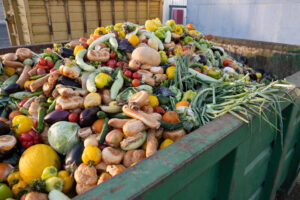How the Grinch Saved Christmas

For decades, the Grinch has had a terrible reputation as a Christmas-hating monster who railed against the festivities of the season and stole the townspeople’s presents, food and decorations in an attempt to stamp out the whole technicolour carnival.
He has become synonymous with anti-joy. But what if we’ve misunderstood the Grinch all this time? What if, he was really just an environmentalist who hated the superficial meaning around Christmas and the extreme overconsumption of stuff?
The 2000 film adaptation of How The Grinch Stole Christmas opens with a scene of Whoville decked out in Christmas décor. The townspeople are running amok, frantically cramming gifts into their baskets, trying to buy as much as they can before Christmas Day. They fight, squabble and stampede towards holiday store discounts, causing the shop assistant to have a meltdown. If you’ve ever gone last minute Christmas shopping, this might sound all too familiar.
How did we get here?
Of course, Christmas wasn’t always the commercial circus we see today, and in the beginning was closer to a secular celebration marking the changing of the seasons. In the US, now infamous for the chaos of its Black Friday sales, the commercial phenomenon really began around the 1840s, when marketers saw the opportunity to introduce the idea of gift giving as a way to push goods. Into the 1920s and 30s mass advertising campaigns gained traction, particularly targeted at children who would pull their parents’ purse strings, cementing the notion that no Christmas was complete without gifts for everyone. When the Coca Cola company painted the image of Father Christmas into their advertising, the transition of Christmas from pagan ritual to retail darling was complete.
The Christmas Waste Problem
Globally, we’re now buying stuff worth almost 66 trillion dollars each year. That’s the equivalent of 2 million dollars per second, and a lot of that is thanks to Christmas, with holiday spending rising significantly each year.
For many, the season has become to epitomise intense human overconsumption and wasteful behaviour. There is also a huge environmental impact that stems from all this gift giving.
In 2023 The Australia Institute research found an estimated 275,000 tonnes of waste is discarded during Christmas. This includes food, trees, flowers, decorations, plastics, cardboard packaging and Christmas cards. What’s worse is that almost half of Australians don’t even want the Christmas presents they receive meaning that on top of the material waste, gifts are thrown away to the tune of $921 million each year.
And it’s not just Australia, the globe has a Christmas waste problem.
In France, the French Agency for Ecological Transition (ADEME) calculated that 6.3 million tonnes of greenhouse gas were emitted during Christmas. Over half (57%) of this was from the production of gifts followed by travel at 25%, food was responsible for 15% of pollution and decorations at 2%.
Similarly, with over 688,000 tonnes of Christmas waste every year, Christmas is the UK’s most wasteful national holiday. 9 out of 10 Brits celebrate Christmas and collectively spend $46.2 billion on holiday celebrations. In comparison to other times of the year, the amount of waste produced at Christmas is 30% higher.
As for the U.S., the average person is accountable for 43% more waste during the festive season. This comes to about 13 kg of trash per week per person. Items like wrapping paper, gift bags, food, plastic and cardboard boxes are the most common items found in holiday trash in the U.S.
The people of Whoville embodied the lifestyle of obsessive Christmas overconsumption until the Grinch, who could take it no more, stole all their Christmas presents, trees, decorations and food. He believed it would rob them of their incessant Christmas cheer and finally give him peace. But instead, it brought them to the realisation that Christmas was about other, less superficial things, like loved ones, family and the spirit of community. This emancipation from material goods allowed the citizens of Whoville to celebrate Christmas in a whole different way, by gathering with their community and singing carols in jubilation.
This caused the Grinch to have a change of heart towards Christmas when he saw how the town had developed a new meaning and purpose behind Christmas. With tears in his eyes and feelings of love in his heart, the Grinch remarked, “Maybe Christmas doesn’t come from a store, maybe Christmas means a little bit more.” Overwhelmed by his emotions, his heart grew 3 times bigger, and he was able to feel the spirit of Christmas.
Be More Grinch-like
We can take a leaf out of the book of Whoville, and re-assess our own obsession with the wasteful accoutrements of Christmas. Here are some ways to embrace a more meaningful Christmas that reduces waste and brings a new, sustainable way to celebrating holidays.
- Presents: We’re filling up landfill with almost a billion dollars’ worth of stuff, just so we can watch half of our friends, families and colleagues pretend to like the gifts we give them at Christmas time. Instead, let’s initiate a culture of Christmas present transparency. Tell people we don’t want a gift this year or if we do, let people know what presents we want. People can open a gift registry (like married couples do) for people to get them something they actually need. Alternatively, gift charity donations, experiences, gift vouchers or personalised, handmade presents. Let’s quit the habit of meaningless gift giving at Christmas.
- Food: Wasted food is a big contributor to greenhouse gas emissions. At Christmas, when we’re piling the table higher than it needs to be, this problem is condensed. Avoid buying excessive amounts of food by making a list and a plan for how you will deal with leftovers before the cooking even begins.
3. Decorations: It is rare for most decorations to last two seasons. Hiring, renting, swapping and making your own is a far better option to buying brand new ones every year. - Trees: Most people reuse their Christmas trees, however, artificial trees are made of PVC (polyvinyl chloride) and are not recyclable. A two-metre artificial tree has a carbon footprint of about 40kg, which, according to the Carbon Trust, is more than ten times that of a real tree that is burned after Christmas. Most of these trees are used for an average of four times before ending up in landfill. Consider renting a tree during the holidays if this is an option in your area.
- Wrapping paper: The lifecycle of wrapping paper is tiny compared to how widely it is used, and it fast becomes Christmas waste. Get creative in reusing materials such as old wrapping paper, ribbons, used gift bags, fabric, scarves and newspaper instead.
- Christmas crackers: The amount of plastic, paper and other raw materials that go into making Christmas crackers, only for them to go waste almost immediately afterward, is not worth the level of entertainment they provide. Fun family games can be found online that can replace the wasteful cracker tradition and also bring laughter to the table.
- Pets: Finally, while not strictly Christmas waste, the habit of temporary pets at Christmas is concerning. In 2022, the RSPCA saw a 70% rise in animals being brought to them after the holidays. When the holiday novelty wears off, pets given as Christmas presents are abandoned when the reality and burden of caring for them on a consistent basis sets in.
Merry Christmas everyone, and while you’re celebrating this year, don’t forget to be more like the Grinch, the guy who eschewed the material obsession with stuff, and ending up saving Christmas.
Between the Lines Newsletter
The biggest stories and the best analysis from the team at the Australia Institute, delivered to your inbox every fortnight.
You might also like
The Seamless scheme and developing an Australian circular textiles industry
Every single year in Australia over 200,000 tonnes of textile waste go to landfill, and more than 100,000 tonnes are shipped overseas. Australia must somehow scale this 300,000-tonne mountain of clothing if the nation is to make the textile industry circular by 2030.
Research Reveals $1.2 Billion Profit from Food Waste
Australian food retailers make $1.2 billion in profit each year from selling food that households waste, according to new research from The Australia Institute.
The War On Waste with Craig Reucassel | Summer Series
Our summer podcast series brings you some of the best conversations from our webinars and live events in 2023. 7 years ago, The ABC’s groundbreaking environmental series War On Waste firmly placed the nation’s attention on Australia’s waste issues and solutions. The new season investigated recycling in Australia, brought to light new waste topics, challenged



